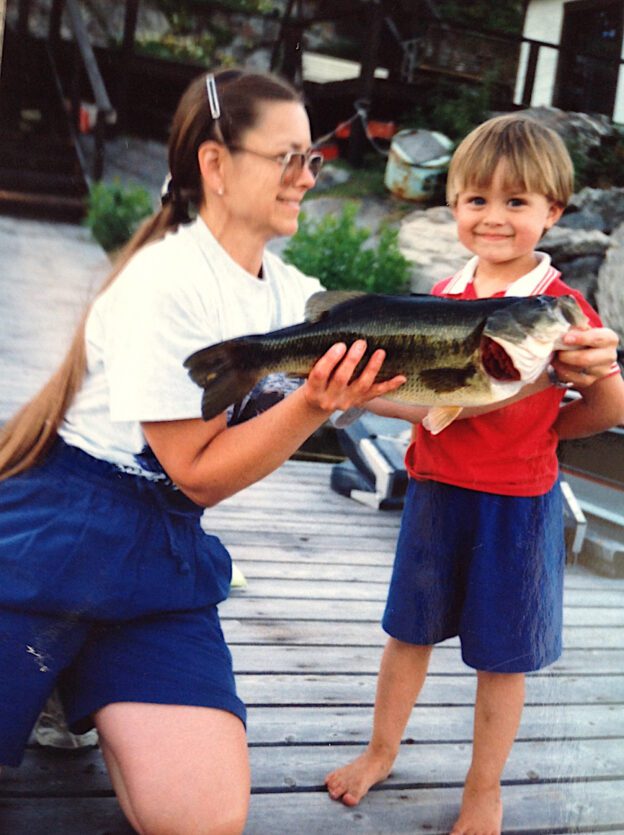Largemouth and Smallmouth Bass are North America’s two favourite sunfish and are among the most popular freshwater game fish. Many fishing tournaments occur annually, along with many fishing shows and of course the amazing destinations you can go fishing for them.
Largemouth and Smallmouth Bass are popular for many reasons and among many more anglers. For myself, they’re always a simple feisty joy to hook back into my youth — fishing with my mother and father out in our guide boat on the French River.

While these two bass may be similar such as their shape, sizes or even a shared river between them. Let’s discuss the differences between Largemouth and Smallmouth Bass and how to catch these fish on the French River.
How to Tell the Difference Between Largemouth and Smallmouth Bass?

There are six distinct features between Largemouth and Smallmouth Bass that differentiate the two species of Black Bass. These physical appearances are:
- Stripes – Largemouth Bass have a broad stripe running horizontally from behind their eye to their tail. Smallmouth Bass have vertical lines starting behind their gill to the end of their tail.
- Mouth Shape – A Smallmouth’s jaw does not extend beyond the medium point of its eye. Whereas, a Largemouth’s jaw extends further behind its eyes. Largemouth are also able to open their mouths wider as a result.
- Dorsal fins – Smallmouth fins are not divided between the spiny section and soft fin section of their dorsal fin. Largemouth’s dorsal fin, however, is visibly gapped with almost an appearance of two separate fins.
- Body Colour – Largemouth Bass are also nicknamed “Green Bass” or “Moss Back” due to their greenish body colour. Meanwhile, Smallmouth Bass are nicknamed “Brown Bass” or “Bronzeback” because of their darker golden-olive to dull bronze-brown body colour. Both Bass species’ colours will change due to diet, stress and environmental conditions.
- Size – While not always the best indicator in similar age classes, Largemouth Bass can and do grow larger than Smallmouth Bass with sizes recorded to be almost two times the size of Smallmouth.
- Cheek Scales – These are difficult to examine, especially on younger fish or if you are planning to release the fish. Largemouth Bass have a larger cheek and have about 17 rows of cheek scales, whereas Smallmouth only has 10 rows.
There are other identifiers such as how they strike your bait or how they fight. Smallmouth Bass tend to be more acrobatic than Largemouth as they flip around the surface of the water to try and throw the hook. Though, fish are like people with their temperament and can vary with size and age.
How to Find Largemouth and Smallmouth Bass?
Now that you can identify between these two Black Bass, where would you catch them? In the French River, despite sharing a river between these two fishes their preferences and habits will rarely overlap. For example, Largemouth tend to favour warmer and sometimes shallower waters whereas Smallmouth tends to favour cooler waters.
Largemouth Bass Habitat

Thick cover is this Black Bass’s best friend. Largemouth Bass are eager to hide in weedy warm water or downfall such as trees and brush piles. They will even take refuge in rocky structures if conditions are right. While Largemouth prefers clear water to hunt in, they are more tolerant of turbidity than Smallmouth.
In the French River, Largemouth Bass do not like strong currents like Smallmouth Bass. They’ll happily be in cover near a break in current as they pick off weaker or younger fish to fatten themselves like hogs.
Smallmouth Bass Habitat
Smallmouth Bass love cover as well but take a different approach from Largemouth Bass. As mentioned earlier, they prefer deeper and clearer water than Largemouth but tend to favour rockier structures to feed. Yes, Smallmouth are the more active hunters of the two Black Bass as they chase baitfish in open water.
Being more athletic, Smallmouth adopted hunting strategies for faster current, falls and chutes on the French River. When fishing current, look for a visible sheen of water or “boils” where water is calmer. They’ll be in areas where they can take advantage of smaller and weaker fish attempting to move through this current, which limits their prey’s mobility.
In Conclusion
So knowing your different Black Bass habits, territories and preferences, most anglers will now know how and where to target Largemouth and Smallmouth Bass. As discussed in the article on selecting a bass fishing rod, you should be on your way to becoming a more avid angler in your choice of species while using the appropriate rod to catch your next lunker or acrobatic smallie. So, jump in your fishing boat and let’s go hunting for Bass and Experience Fishing!
Article by Joe Barefoot, M.B., Outdoor Writer of Canada and Nationally Published Author & Photographer
For More In-Depth Bass Fishing Articles:
- Largemouth Bass Fishing in Ontario: A Beginner’s Guide
- Hooked on the River: Smallmouth Bass Fishing Secrets
- Walleye vs Bass: What Fish is the Catch of the Day?















































